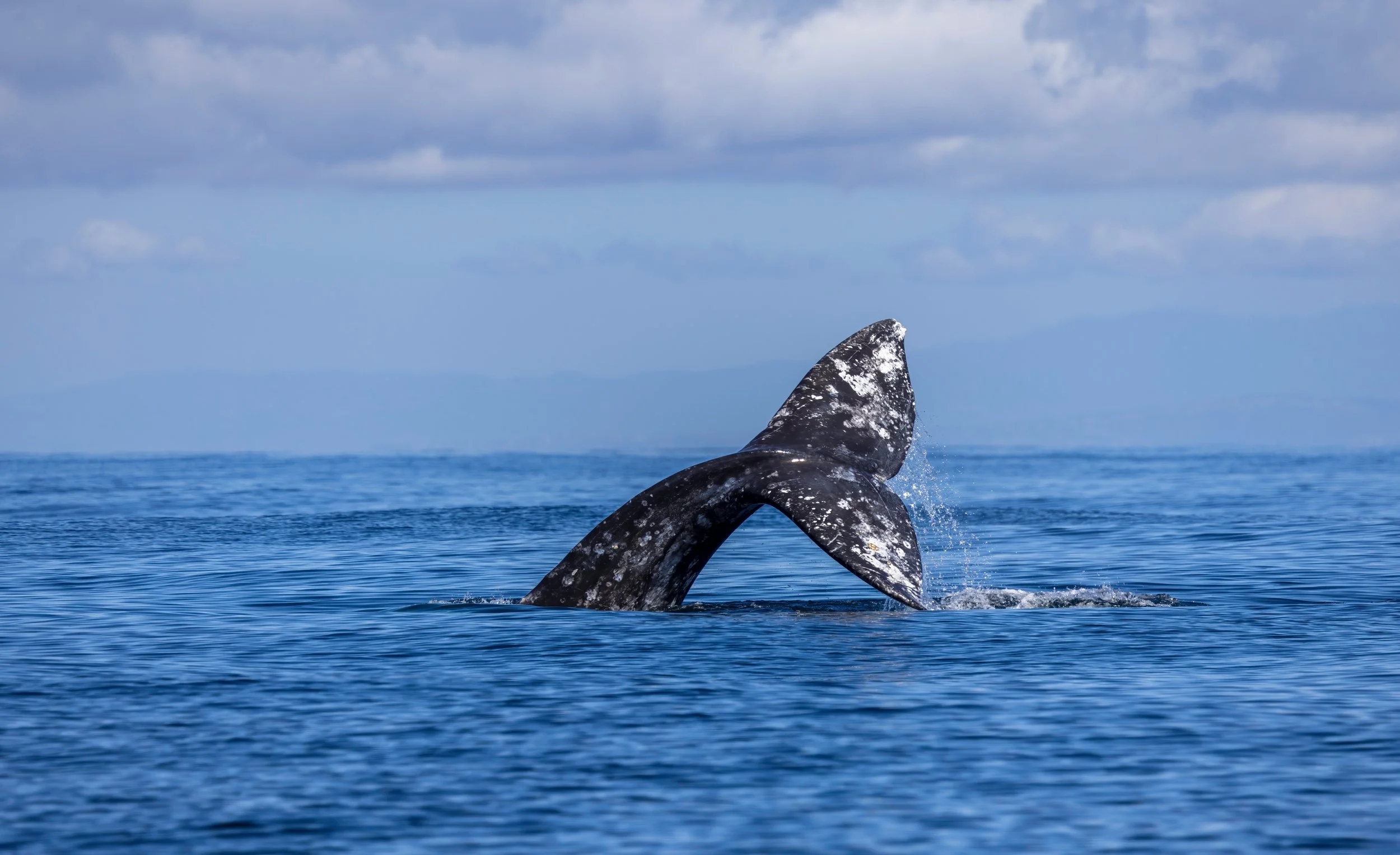The tail end of the year
Giants make their presents felt at Whale Watch Week
By Michael Edwards
For the TODAY
A pregnant female gray whale rises from the murky shallows of the Chukchi Sea. As she nears the surface, a trail of mud passes over her baleen into the frigid water. She surfaces and breathes a rancid mist into the fog. Though the whale is comfortably ahead of the forming pack ice, her season of dredging amphipods from the abundant Arctic benthos is ending.
Whale Watching spoken here
Though whales are visible from Oregon’s shores all year long, some months are better than others.
In the winter, thousands of gray whales will travel south from their Arctic summer feeding sites to the warm waters off Baja California in Mexico.
On the Central Coast, nine lookout points from Cape Meares to the Heceta Head Lighthouse will be staffed with volunteers from 10 am to 1 pm, Wednesday, Dec. 27, through Sunday, Dec. 31.
Year-round park staff are also ready to answer questions and help watchers spot spouts at the Whale Watching Center in Depoe Bay.
Volunteers and park staff can offer details about whale swimming patterns and habits, such as breaching, spyhopping and diving.
Other fun ways to watch for whales is by hiking to the point at Cape Lookout, a roughly five-mile round trip, or from the cozy comfort in the Fathoms Restaurant inside the Inn at Spanish Head in Lincoln City.
Staffed spotting spots include:
Cape Meares Lighthouse
Boiler Bay State Scenic Viewpoint
The Whale Watching Center in Depoe Bay
Rocky Creek State Scenic Viewpoint
Cape Foulweather
Yaquina Head Outstanding Natural Area
Yachats State Recreation Area
Cape Perpetua Turnout
Heceta Head Lighthouse
For more information, go to stateparks.oregon.gov.
With a healthy girth she hasn’t carried in several seasons, the gray whale passes through the Bering Strait. Near the frozen Siberian shore, she spies a familiar old bull bowhead whale. His enormous head is scarred from 176 winters spent smashing through sea ice. The frisbee-sized chunk missing from his fluke is the product of an errant harpoon, thrown by a seasick Soviet whaler during the days of Lenin. Though the pack ice is thinner today than it was during the Russian Revolution, it’s plenty thick enough to drown a gray whale. She continues southbound into a brewing cyclone.
At the crest of a frosty Bering Sea swell, crab boat fishermen armed with Louisville sluggers break ice off the boat’s bow, while wading in the trough below, our heroine, the 48-foot, 90,000-pound behemoth, takes two breaths and slips unnoticed beneath the whitecaps, then passes safely through Unimak Pass into the boundless Pacific. There she follows an eastern arc past glaciated peaks and a pod of irritatingly happy belugas. The gray whale turns south. Ice and rock give way to rain and spruces. She steams past the salmon forest of the Tongass and the kingdom of the spirit bear.
Off Cape Flattery, a solar storm introduces interference into the whale’s magnetoreception system. She swims dangerously close to shore and surfaces into a raft of sea otters rising and falling with the swells. Oblivious to her intrusion, the otters continue to smash crabs with stones and feast. The radio interference wanes and the whale leaves the distortion of crashing surf and twirling otters in her wake.
At the Depoe Bay Whale Watching Center, Ranger Justin Duering shows a little boy how to use binoculars and orients him towards the far buoy. The boy shouts, “I see a spout!” A volunteer points out the boy’s find on the big screen. This isn’t the old gray whale’s first time on the big screen.
Cape Mendicino’s golden glow bathes the vertical fin of an orca. Like the one that broke our gray whale’s rib on her maiden voyage, this orca is big, but she is bigger. Near Point Reyes, the whale lingers in the waters where, two winters ago, she delivered her calf prematurely. This year, she and her baby will make it to Mexico.
Between a derelict oil platform and Annacapa Island, she detects the haunting moan of a humpback whale. The humpback clan has added a note to their song. Though she believes them show offs, what with their elaborate tunes and incessant breaching, the gray whale has learned to appreciate the humpbacks’ talents. Besides, those showboats will never match her kind’s endurance.
Into the industrial soundscape of San Pedro the gray whale weaves through a gauntlet of freighters stacked with Toyotas and cargo containers full of bric-a-brac. Three miles off Camp Pendleton, she spy-hops into a smoke blanket generated by a chaparral fire blown seaward by a Christmas Santa Ana. Through stinging eyes she spots a fellow expecting mother surfacing. Together they accelerate south.
Off Point Cabrillo, the whale’s nap is punctured by a contraction and the riot of a dolphin super pod and an albacore school pursuing shoals of anchovies. New Year’s Eve brings explosions and light to the Ensenada night sky. A fading cacophony of accordions, horns and singing serenades the matriarch as she enters the desert leg of her journey. Dawn is silent and warm. Her breath evaporates in the desert air. Sand tickles her back.
After entering Laguna San Ignacio’s protected waters, her baby boy enters the world tail first. The next day, the mother gray whale detects the familiar voice of Javier, the panga boat captain who has looked after her kind for the past 25 winters. Javier introduces his old friend to his euphoric, sunburnt passengers. A couple from Minnesota reaches into the warm, green sea and touches the newborn’s slick, gray nose. The otherwise stoic Gustafsons gush happy tears. Javier gives his tired-but-alert friend a wink and a head scratch.
The whale leans into the captain’s touch and exhales.
“Bienvenida a casa, gran dama.”

